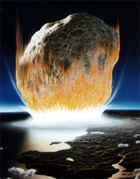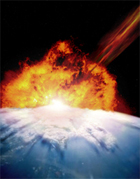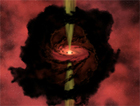How is Bianstone formed?
1. Impact
 When high-speed iron meteorite charging towards the earth enters the atmosphere, an intense friction occurs between the surface of the meteorite and the atmosphere, resulting in a continuous combustion and explosion. And in the process of combustion and explosion, high-temperature and equal-pressure plasma air masses form. 5,6,7 Plasma is a kind of air mass mainly composed of free electrons and charged ions.
When high-speed iron meteorite charging towards the earth enters the atmosphere, an intense friction occurs between the surface of the meteorite and the atmosphere, resulting in a continuous combustion and explosion. And in the process of combustion and explosion, high-temperature and equal-pressure plasma air masses form. 5,6,7 Plasma is a kind of air mass mainly composed of free electrons and charged ions.
 When high-speed iron meteorite charging towards the earth enters the atmosphere, an intense friction occurs between the surface of the meteorite and the atmosphere, resulting in a continuous combustion and explosion. And in the process of combustion and explosion, high-temperature and equal-pressure plasma air masses form. 5,6,7 Plasma is a kind of air mass mainly composed of free electrons and charged ions.
When high-speed iron meteorite charging towards the earth enters the atmosphere, an intense friction occurs between the surface of the meteorite and the atmosphere, resulting in a continuous combustion and explosion. And in the process of combustion and explosion, high-temperature and equal-pressure plasma air masses form. 5,6,7 Plasma is a kind of air mass mainly composed of free electrons and charged ions.
2. Mach Effect
 The plasma that remains on the earth's surface forms a special space. Possessing a high conductivity, the air mass expands continuously under the influence of the strong coupling action with the electro-magnetic field. According to Mach Effect, as the temperature of plasma drops, a fluid mechanics separation happens to the plasma near the earth's surface, yielding three kinds of particles: 5,6,7 free electrons, ions with positive charges and atoms without charges. These particles of different density fill up the atmosphere.
The plasma that remains on the earth's surface forms a special space. Possessing a high conductivity, the air mass expands continuously under the influence of the strong coupling action with the electro-magnetic field. According to Mach Effect, as the temperature of plasma drops, a fluid mechanics separation happens to the plasma near the earth's surface, yielding three kinds of particles: 5,6,7 free electrons, ions with positive charges and atoms without charges. These particles of different density fill up the atmosphere.
 The plasma that remains on the earth's surface forms a special space. Possessing a high conductivity, the air mass expands continuously under the influence of the strong coupling action with the electro-magnetic field. According to Mach Effect, as the temperature of plasma drops, a fluid mechanics separation happens to the plasma near the earth's surface, yielding three kinds of particles: 5,6,7 free electrons, ions with positive charges and atoms without charges. These particles of different density fill up the atmosphere.
The plasma that remains on the earth's surface forms a special space. Possessing a high conductivity, the air mass expands continuously under the influence of the strong coupling action with the electro-magnetic field. According to Mach Effect, as the temperature of plasma drops, a fluid mechanics separation happens to the plasma near the earth's surface, yielding three kinds of particles: 5,6,7 free electrons, ions with positive charges and atoms without charges. These particles of different density fill up the atmosphere.
3. Explosion
 When the meteorite crashes into the ground, a violent explosion happens. The explosion generates a blast wave and releases an enormous amount of energy, flinging the solid explosives in the vicinity into the sky, and leaving again the plasma over the ground in a state of high temperature and high pressure.
When the meteorite crashes into the ground, a violent explosion happens. The explosion generates a blast wave and releases an enormous amount of energy, flinging the solid explosives in the vicinity into the sky, and leaving again the plasma over the ground in a state of high temperature and high pressure.
 When the meteorite crashes into the ground, a violent explosion happens. The explosion generates a blast wave and releases an enormous amount of energy, flinging the solid explosives in the vicinity into the sky, and leaving again the plasma over the ground in a state of high temperature and high pressure.
When the meteorite crashes into the ground, a violent explosion happens. The explosion generates a blast wave and releases an enormous amount of energy, flinging the solid explosives in the vicinity into the sky, and leaving again the plasma over the ground in a state of high temperature and high pressure.
4. Fumigation effect
 In this particularly complex environment, plasma comes to possess a high fluidity and permeability. Under the fumigation effect of high temperature and pressure and thanks to the penetration of plasma, a variety of elements produced by the explosion infiltrate into the stones precipitated into the air during the explosion.
In this particularly complex environment, plasma comes to possess a high fluidity and permeability. Under the fumigation effect of high temperature and pressure and thanks to the penetration of plasma, a variety of elements produced by the explosion infiltrate into the stones precipitated into the air during the explosion.
 In this particularly complex environment, plasma comes to possess a high fluidity and permeability. Under the fumigation effect of high temperature and pressure and thanks to the penetration of plasma, a variety of elements produced by the explosion infiltrate into the stones precipitated into the air during the explosion.
In this particularly complex environment, plasma comes to possess a high fluidity and permeability. Under the fumigation effect of high temperature and pressure and thanks to the penetration of plasma, a variety of elements produced by the explosion infiltrate into the stones precipitated into the air during the explosion.
5. Formation
 As the explosion-caused substances fall, pumice is gradually formed, and after a rapid cooling process, pumice condenses into some microcrystalline structure, which is what we call Bianstone.
As the explosion-caused substances fall, pumice is gradually formed, and after a rapid cooling process, pumice condenses into some microcrystalline structure, which is what we call Bianstone.
 As the explosion-caused substances fall, pumice is gradually formed, and after a rapid cooling process, pumice condenses into some microcrystalline structure, which is what we call Bianstone.
As the explosion-caused substances fall, pumice is gradually formed, and after a rapid cooling process, pumice condenses into some microcrystalline structure, which is what we call Bianstone.
 I am Kathering Olsson and I went to Hong Kong in 2010. And it is totally by chance that I stumbled upon the magic bianstone there. I am a apps developer and my work involves long-hour sitting in front of the computer and scribbling every day. The work nature seemed to torment me forever. My neck was always painful and I could not sleep well. Thanks to Bianstone! After wearing the bracelet and putting the bianstone under my pillow, things changed completely ever since. The magic stone stay me head calm and I can sleep very well since then! Moreover, the bianstone bracelets really make my wrists recover faster from capal tensions caused by too much typing. I had already bought some more bianstone necklaces, electro-heating bianstone device from TherapeuticStone for my family. My mum told me she felt awesome when she did meditation on the Electrical Heating Stone Seat Cushion. Hope you folks can also benefit from the magic stone from China.
I am Kathering Olsson and I went to Hong Kong in 2010. And it is totally by chance that I stumbled upon the magic bianstone there. I am a apps developer and my work involves long-hour sitting in front of the computer and scribbling every day. The work nature seemed to torment me forever. My neck was always painful and I could not sleep well. Thanks to Bianstone! After wearing the bracelet and putting the bianstone under my pillow, things changed completely ever since. The magic stone stay me head calm and I can sleep very well since then! Moreover, the bianstone bracelets really make my wrists recover faster from capal tensions caused by too much typing. I had already bought some more bianstone necklaces, electro-heating bianstone device from TherapeuticStone for my family. My mum told me she felt awesome when she did meditation on the Electrical Heating Stone Seat Cushion. Hope you folks can also benefit from the magic stone from China.